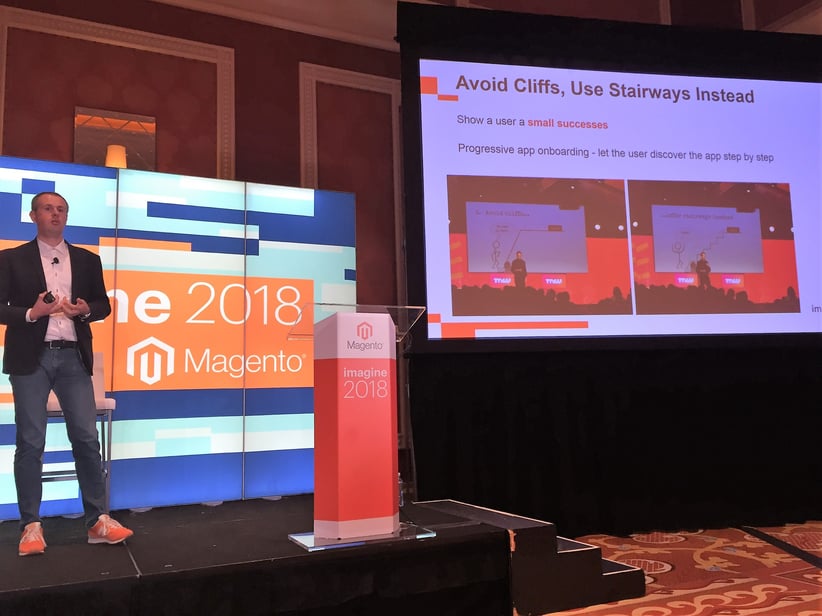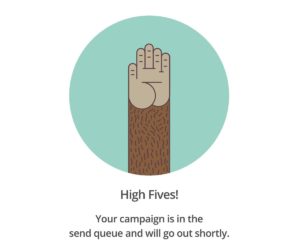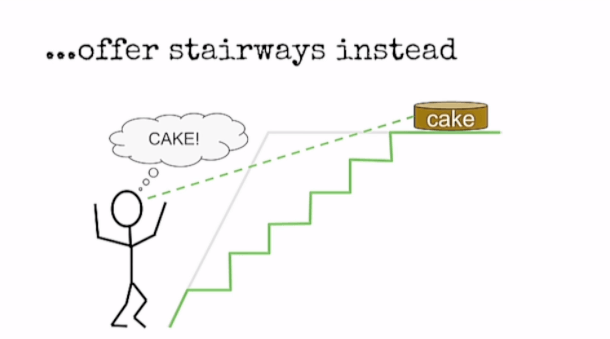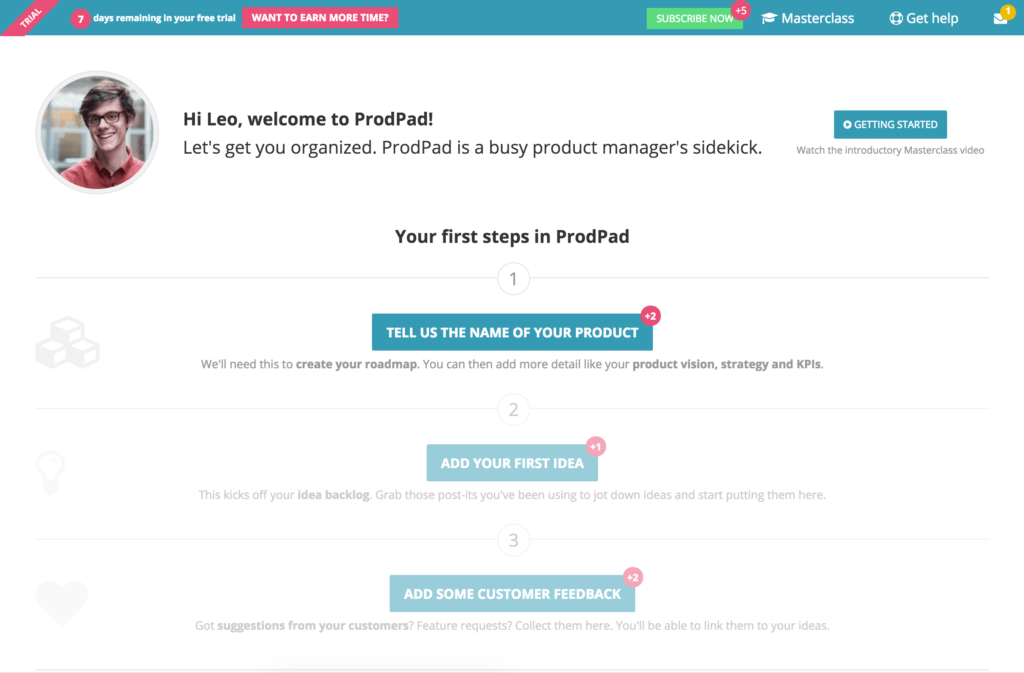Building an eCommerce Platform is one thing, but getting users engaged is another. In the world of digital transformation, the second part is even more important. Why?
Because we all fail at onboarding users. The failure ratio for web-apps is 40-60%, for mobile apps it is 70-80% and… just wait for it… 97% for voice apps… yes. This is all about building expensive software and then onboarding users in the worst possible way. It even seems that with each new channel we get worse in understanding our users.
That’s why I decided to share my experience at Magento Imagine – it is the biggest Magento conference, and Magento itself is the most popular enterprise B2B platform. Well, it just looked like the best place to discuss onboarding B2B commerce users.
What is client onboarding?
Just to be clear – client onboarding is the process of welcoming new users to your eCommerce. It is the first impression for your new customers, and it takes some time to think through the whole process, address your customers’ needs, and answer their questions and concerns. You must let them understand what services you offer them. Relying on eCommerce service structure is just not enough. You must build user engagement.
I’ve been developing eCommerce since 2004, and I have seen how successful clients can be in digitizing their businesses and how they on-board users. Probably the best case I have ever seen up close was TIM (check: case study). We started cooperation with TIM in 2011. As Divante, we assisted them to move 80% of revenue from offline to online and then we helped them to grow about 20% each year for the next 3 years. Today, TIM has about 170M Euro in revenue. But I have also worked with multiple other B2B companies, helping them to go fully digital.
Today I will share with you the best ideas I have seen.
The Initial Success Concept
The whole idea of Initial Success is to engage the user, to convince him to do something, and show him tangible output that is important for him. So he or she can say.. aha, now I got it!
by Mailchimp
The initial success concept (aka “aha moment”, or “wow moment”) is all about the users’ needs and our fast and accurate response. This is why you first need to know your user. If you work for a specific industry for the first time, I strongly advise you to conduct user research, and it is best if you do some field research – Yes, I mean spending time with end clients, observing how they work, and learning what is important to them. Only then you can properly create personas – usually 3-4 per each project. Trust me, knowing what’s important for the personas is crucial in onboarding scenarios.
Knowing when the user achieves the initial success is also very helpful in the process of closing the deal. The best time for you to ask for closure is when the user is achieving his initial success.
Progressive Onboarding Concept
Some 3 years ago, at The Next Web Conference, Jonathan Rochelle (@GoogleDocs & @GoogleDrive cofounder) told us about how they onboard users. They “avoid cliffs, use staircase instead”. This means you shouldn’t overwhelm users, just show them the next related feature, another small success. The user should be in charge of the process.
Knowing these two concepts, you can usually onboard users quite smoothly.
Go beyond onboarding basics
In Divante we have had some really good ideas for onboarding. They can help you increase the success ratio in your eCommerce. Here are the best of our client onboarding ideas:
Trial Period
Sometimes you need to give the user time to familiarize herself with the platform before taking a decision. Only after that, you can sign an agreement and the user must pay for the services you deliver. But that period can differ from the product or customer. What I really like is a dynamic trial period.
The guys from Prod Pad decreased their trial period from 30 to 7 days, but what they offered instead was additional days if the user is active. For example, you add your project name and you will get 2 additional free days of trial.
By doing so they were able to increase conversion from trial to buy by 300%.
Entering the Data
People really hate to enter data manually and they are more likely to finish things that are already 60% completed. The actionable idea here is to import as much data as possible automatically. But what to do when this is a new client and you don’t have any data? Use external databases like Clearbit. I can imagine a situation in which a client gives you just his email and then you can use Clearbit to download all the data about the company.
This is also why at Divante, we created Oxi. This is a clever tool that crawls all the data between sales reps and clients, figures out what is what, and then uploads all entities to the client account in Magento. So when the client logs in, he sees all the offers, deals, and attachments that he has already discussed in other channels.
Phone support
Clients need a support channel when you introduce eCommerce. Probably, the best is still the phone, as it is the most emotional and brings us closest to clients. What is really important – call centers should help clients, not do the work for them. So the client should make an order, not the sales rep from the call-center.
Bots
Another really good channel for intermediate support is bots. But please, remember that not all B2B buyers are millennials. Not everyone understands that the response was created by an algorithm, so always be very cautious about the quality of the bots that you are using. A good example here is Slackbot. This bot just says “I will try to help, but sorry, I’m just a bot”.
Sales Team
The best onboarding tool is your sales slack force. These guys know the clients the best and know how to convince them. Try to figure out the model that engages your sales reps. A new goal, for example, could be to visit as many clients as possible and onboard them manually to the platform. If you align quotas and commission with the new channel, they will very quickly understand they can earn even more. Your sales team should hunt for new clients and the framing is done by the system.
Safety Net
In B2B, the value of the average order could easily be in millions. So don’t expect users to just start playing with the system. You need to build a safety net that will help them. The basic idea is to print some old-school flyers (the best are checklists). You will thank me when you see your clients making their first orders with the checklist on their desk.
Another idea is to have an open demo account that helps users get familiar with the system without being afraid of making a mistake. The main problem with the demo account is, though, with the initial success – it’s just hard to get users engaged here.
Proof of value
You can also create proof of value to boost your initial success ratio. A video is a great tool for that. Simply show users what you have. One of our clients created a live video streaming from their warehouse to show that they possess all offered goods and they can send them instantly when you order.
Conflicts in distributions channels
Of course, there are still companies that sabotage themselves in b2b eCommerce onboarding (e.g. they offer different prices offline and online because they don’t have tools to negotiate online price). The reason for this is subconscious fear of conflicts in distribution channels.
We can always do something here. The first idea that comes to the mind is to build non-transactional system based on Product Catalogue or Loyalty/Motivational Program. With inviting clients to such app you can start building the digital bond with them. Having products database and customers database first makes building eCommerce much easier.
As you can see, there are plenty of quite easy to implement ideas that can boost your onboarding ratio and help you digitize your business. To learn more you can contact me @tomik99 or see my presentation from Magento Imagine 2018:
Published May 7, 2018
















